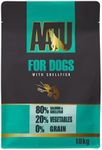Buying Guide for the Best Dry Dog Food
Choosing the right dry dog food is crucial for your pet's health and well-being. It's important to consider your dog's age, size, breed, and any specific dietary needs they may have. A balanced diet will ensure your dog gets the necessary nutrients to maintain energy levels, support growth, and keep their coat shiny and healthy. When selecting dry dog food, pay attention to the ingredients, nutritional content, and any special formulations that might benefit your dog. Always consult with your veterinarian if you're unsure about what food is best for your pet.IngredientsIngredients are the components that make up the dog food. They are important because they determine the nutritional value and quality of the food. Look for foods with high-quality protein sources like chicken, beef, or fish as the first ingredient, as these are essential for muscle development and energy. Avoid foods with fillers like corn or soy, which offer little nutritional value. If your dog has allergies or sensitivities, you may need to choose a food with limited ingredients or a specific protein source.
Protein ContentProtein content refers to the percentage of protein in the dog food. Protein is crucial for your dog's growth, muscle maintenance, and overall health. Foods with higher protein content are generally better for active dogs or those with higher energy needs. For less active or older dogs, a moderate protein level may be more appropriate. Always ensure the protein source is high-quality and easily digestible.
Fat ContentFat content is the amount of fat present in the dog food, which provides energy and helps with nutrient absorption. It's important because it supports your dog's skin and coat health, as well as overall energy levels. Active dogs or those with higher energy needs may benefit from higher fat content, while less active or overweight dogs may require lower fat levels to prevent weight gain.
Fiber ContentFiber content refers to the amount of fiber in the dog food, which aids in digestion and helps maintain healthy bowel movements. It's important for dogs with digestive issues or those prone to constipation. Foods with higher fiber content can help regulate digestion, while lower fiber foods may be suitable for dogs with sensitive stomachs or those who need a more calorie-dense diet.
Life StageLife stage indicates the age group the dog food is formulated for, such as puppy, adult, or senior. This is important because dogs have different nutritional needs at various stages of their life. Puppies require food with higher protein and fat for growth, adults need balanced nutrition for maintenance, and seniors may need food with joint support or lower calories. Choose a food that matches your dog's current life stage to ensure they receive the appropriate nutrients.
Breed SizeBreed size refers to the size category the dog food is designed for, such as small, medium, or large breeds. This is important because different breed sizes have varying nutritional requirements and kibble sizes. Small breeds may need food with higher calorie density and smaller kibble, while large breeds may benefit from food with joint support and larger kibble. Select a food that matches your dog's breed size to ensure they can eat comfortably and receive the right nutrition.
Special FormulationsSpecial formulations are dog foods designed to address specific health concerns or dietary needs, such as weight management, grain-free, or hypoallergenic options. These are important for dogs with specific health issues or dietary restrictions. If your dog has a condition like obesity, allergies, or digestive problems, consider a special formulation that targets these needs. Consult with your veterinarian to determine if a special formulation is necessary for your dog.
















